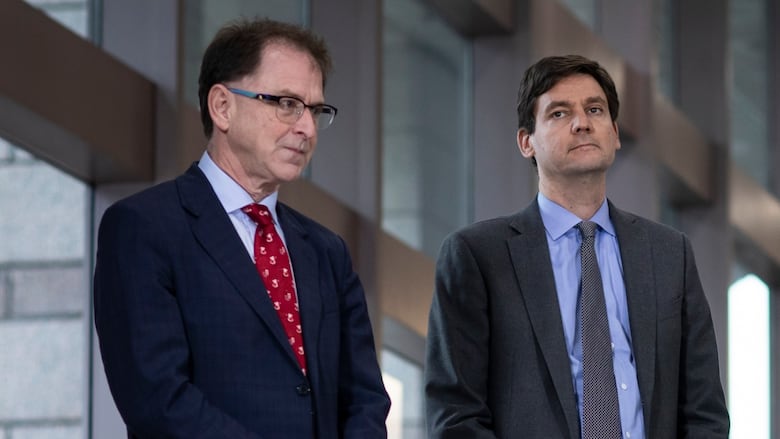B.C. government accused of 'greenwashing' as it announces $200M to electrify LNG project
Premier says Indigenous-owned Cedar LNG project will help Canada diversity its energy markets

The B.C. government is taking heat from the B.C. Green Party and a political science professor following its announcement of $200 million in subsidies for an upcoming LNG project majority owned by the Haisla Nation.
The Cedar LNG project, a collaboration between Calgary-based Pembina Pipeline Corp. and the Haisla First Nation, is a floating liquefied natural gas export facility off B.C.'s North Coast set to come online in 2028.
On Monday, B.C. Energy Minister Adrian Dix and Premier David Eby announced that the province would kick in $200 million to support the electrification of the project, including a new transmission line and substation.
The B.C. government argues that its support for the project, one of several projects it wants to fast-track in order to stave off the threat imposed by U.S. tariffs, will allow for the exported product to appeal to markets outside the U.S.

"Our market position, our proximity to the Asian market, makes it the best LNG in the world, and it's the lowest-emission LNG in the world," Dix told a news conference on Tuesday. "And that is an achievement.
"It's not just a question of displacing coal or other dirtier fuels," he added. "It's displacing other LNG, which has dramatically higher emissions."
But environmentalists disagree with the decision, saying that taxpayers shouldn't be on the hook for a fossil fuel project, and that electrifying the project would do little to offset its ultimate carbon footprint.
"It is facilitating production and shipment of fossil fuels, which are the main cause of climate change," said Kathryn Harrison, a professor of political science at the University of B.C.
"Even if British Columbia has very low-emitting terminals, most of the emissions associated with every ton of that LNG [is] released at the point of combustion," she added.
Questions over LNG viability
Harrison questioned what the market prospects for B.C.'s LNG were, saying there were many projects coming online in other countries like the U.S., Australia and Qatar.
"Last year, the International Energy Agency's report expected that there would be a glut of LNG relative to global demand by 2030," she said.
"If that happens, there is a big question about the financial viability of these projects and especially whether we will see government step in with taxpayer monies to prop them up yet again," she added.

Jeremy Valeriote, the interim leader of the B.C. Greens, said that public funds for an industry that "may not stand the test of time" was problematic.
"It's greenwashing because it's still an unsustainable form of fuel," Valeriote said.
"Taking a tiny part of a high-emission fossil fuel and making it a little bit more green doesn't suddenly make it a sustainable fuel."
"It's going to have a really hard time competing with other low-cost producers like Qatar and other countries," he said.
"So it ends up some of the most expensive, which means it's the least competitive, which means it's possibly the first to fall off the block as global demand for LNG starts to go down."

John Rustad, the leader of the B.C. Conservatives, expressed concerns about whether B.C.'s LNG industry was competitive on the global market.
He was critical of permitting times in B.C., saying that it was taking years for proposed LNG projects to come online.
"We started LNG in British Columbia 15 years ago," he said.
"Americans didn't even consider starting it until 12 years ago. We've managed to get one plant up, one major plant up and running. They have 16."

$5.9 billion project
Originally valued at $3 billion, the federal government says that Cedar LNG will cost an estimated $5.9 billion to build, creating 300 jobs during construction and 100 full-time jobs once operational. It is among seven proposed LNG projects at various stages of development in Canada.
The project consists of a floating natural gas liquefaction plant and marine export terminal located in the Douglas Channel near Kitimaat Village, a Haisla community approximately 380 kilometres directly west of Prince George, B.C.

It will have the capacity to liquefy approximately 3.3 million tonnes of natural gas per year for export to Asian markets when it becomes operational in late 2028.
For his part, Eby is bullish about the facility and its potential to ship LNG to non-U.S. markets.
He said that Cedar LNG was the largest Indigenous-owned energy project in North America, and called it a positive for both B.C. and Canada as a whole.
"Canada will win this race and we will diversify our markets because of our Canadian values," he said. "And those are on display on this project right here at Cedar LNG."
With files from Katie DeRosa and The Canadian Press



